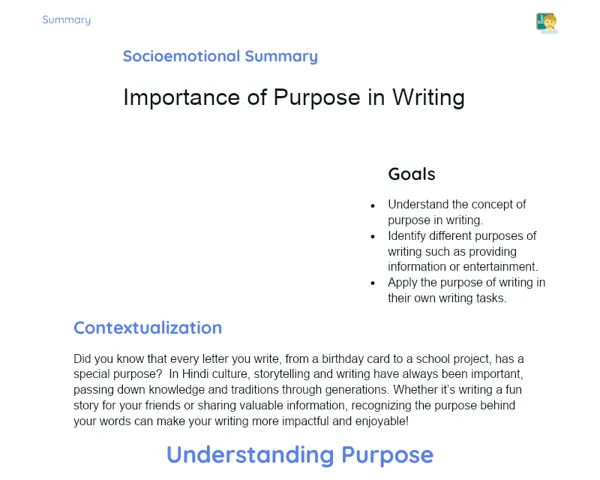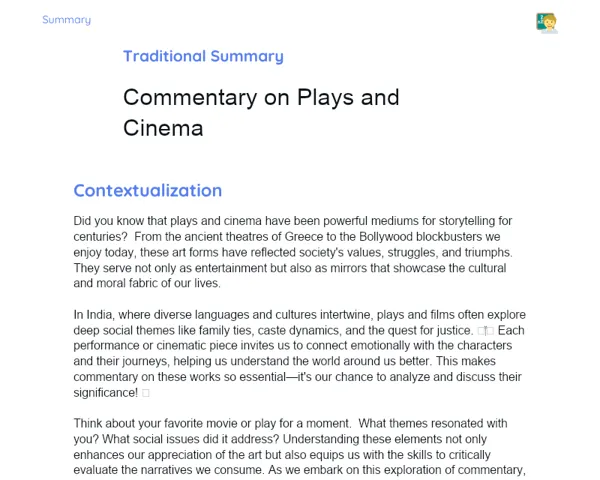Unlocking the Language of Emotion: Mastering Hindi Sentence Structures
Goals
1. Understand the basic components of a sentence in Hindi, such as subject, verb, and object.
2. Identify the correct order of these components to construct meaningful sentences.
3. Enhance your ability to express thoughts clearly and effectively in written and spoken Hindi.
Contextualization
Did you know that mastering sentence structure is like learning the rhythm in a Bollywood song? Just as every beat and note comes together to create beautiful music, the parts of a sentence join together to form powerful expressions of your thoughts and emotions! When you get this right, it’s like having a key to unlock deeper communication with your friends and family. So let's dance to the beat of words and explore the magic behind sentence structures!
Exercising Your Knowledge
Subject
The subject is the heart of a sentence, representing who or what the sentence is about. In Hindi, the subject usually comes at the beginning of the sentence and sets the tone for the information that follows. It’s like the main character in a story; without it, the sentence loses its direction and meaning. In a socioemotional context, identifying the subject helps you understand the perspective from which a thought is expressed, allowing you to connect more deeply with the feelings and intentions behind the words.
-
Central Focus: The subject is crucial because it determines the action of the verb and the overall meaning of the sentence. Understanding who is doing what helps clarify your message.
-
Emotional Engagement: By recognizing the subject, you can empathize with the character or idea being discussed, boosting your emotional intelligence.
-
Cultural Context: In Hindi, subjects can also reflect cultural nuances, such as respect. For instance, certain words convey politeness depending on the subject, helping you build healthier social relationships.
Verb
The verb is the action that gives life to the sentence. It tells us what the subject is doing, feeling, or experiencing. Verbs can express various moods and tenses, helping convey emotional depth. In Hindi, verbs can change form based on the subject, which creates a more personalized interaction. Understanding verbs can empower you to express yourself more vividly, enhancing your communication skills and enabling better connections with others.
-
Action Orientation: Verbs are essential as they describe actions or states of being. They provide clarity and direction, making your communication dynamic.
-
Emotional Nuance: Different verbs can evoke various emotional responses. For example, saying 'play' versus 'struggle' conveys vastly different feelings, enabling you to express a situation accurately.
-
Cultural Significance: The choice of verb can reflect cultural values and practices in Hindi, highlighting behaviors and attitudes prevalent in society.
Object
The object complements the action of the verb by indicating what is affected by it. In Hindi sentences, the object typically follows the verb and adds depth to the expression, painting a clearer picture of a situation. By identifying the object in a sentence, you enhance your understanding of relationships and interactions, which is key in nurturing emotional intelligence and social awareness.
-
Completeness: The object completes the idea expressed by the verb and subject, making your sentences whole and meaningful.
-
Understanding Relationships: Knowing the object allows you to see the connection between the action and its recipient, fostering a deeper understanding of interpersonal dynamics.
-
Language Enrichment: By learning how to identify and use different objects in sentences, you can expand your vocabulary and refine your linguistic skills, elevating your expression.
Key Terms
-
Subject: The part of the sentence that indicates who or what the sentence is about. It is essential for understanding the context and focus of the sentence.
-
Verb: The action word in a sentence that describes what the subject is doing. It adds life and emotion to the sentence.
-
Object: The part of the sentence that receives the action of the verb. It helps clarify the relationship between the subject and the action.
For Reflection
-
How can understanding the structure of a sentence improve your ability to express your emotions and thoughts more clearly? Reflect on an instance where you felt misunderstood due to unclear communication.
-
In what ways can learning about subjects, verbs, and objects help you empathize with others in your daily interactions? Consider a recent conversation and how better sentence structure could have changed its outcome.
-
How does mastering sentence structure empower you to connect with your cultural identity and express it in conversations? Reflect on your experiences using Hindi in different social settings.
Important Conclusions
-
We explored the components of a Hindi sentence: the Subject, Verb, and Object.
-
Understanding sentence structure boosts your ability to express thoughts clearly and effectively.
-
Mastering these elements not only improves your language skills but also enhances your emotional intelligence and social connections.
Impacts on Society
In today's world, effective communication is more important than ever. As young learners, understanding sentence structures empowers you to participate in conversations that shape your communities. It’s not just about grammar—every time you articulate your thoughts clearly, you foster stronger relationships and build empathy among your peers. Just think about it! When you confidently express yourself, you impact the way people perceive and connect with you, leading to more meaningful interactions.
Moreover, as we navigate the rich tapestry of our diverse society, mastering Hindi sentence structures allows us to express cultural nuances and values effectively. By incorporating emotional intelligence into our communication, we become better leaders and collaborators in various settings, from school projects to family discussions. The ability to convey feelings and perspectives through language strengthens the cultural fabric of our society, showcasing the beauty of our shared experiences.
Dealing with Emotions
To help you manage your emotions while studying sentence structures, let’s use the RULER method! Start by recognizing how understanding sentence components (Subject, Verb, and Object) makes you feel. Are you excited, curious, or even confused? Write down these feelings. Next, understand why you feel this way—perhaps it's due to a desire to communicate better with your friends or family. Now, accurately label these emotions, such as 'enthusiasm for learning' or 'frustration with complex concepts.' Let your emotions flow as you express them through a short paragraph or a creative doodle!
Finally, regulate your emotions by reflecting on how improved communication can lead to better understanding with those around you. If you ever feel overwhelmed while practicing, take a break, breathe deeply, and remind yourself that every mastering skill takes time. Embrace this journey, and remember that practicing language can also be a fun emotional outlet!
Study Tips
-
Read Hindi stories, poems, or dialogues and try identifying the subjects, verbs, and objects in each sentence.
-
Practice writing your own sentences by changing subjects and objects while keeping the verbs consistent—notice how it changes the meaning!
-
Engage in discussions with friends or family using Hindi, focusing on clearly expressing your ideas—pay attention to sentence structure.



